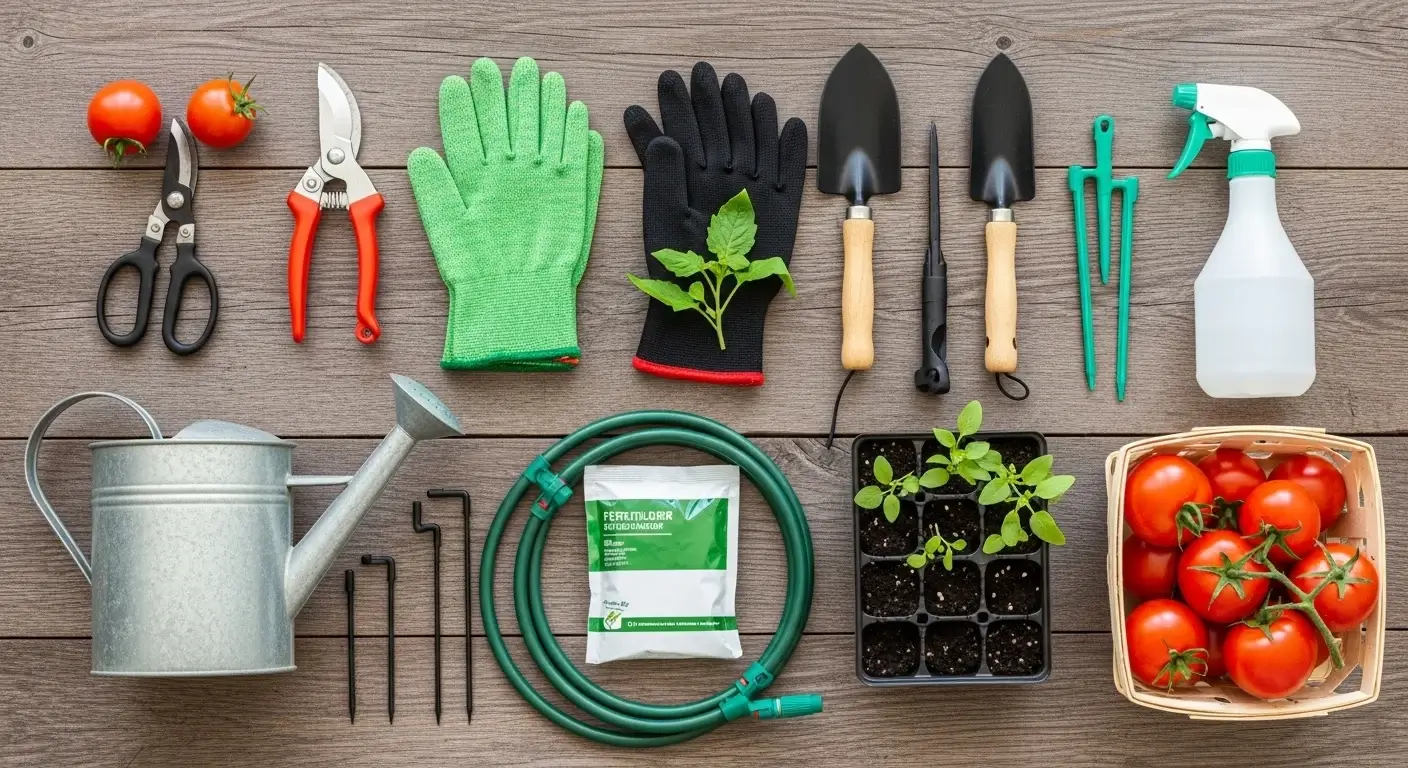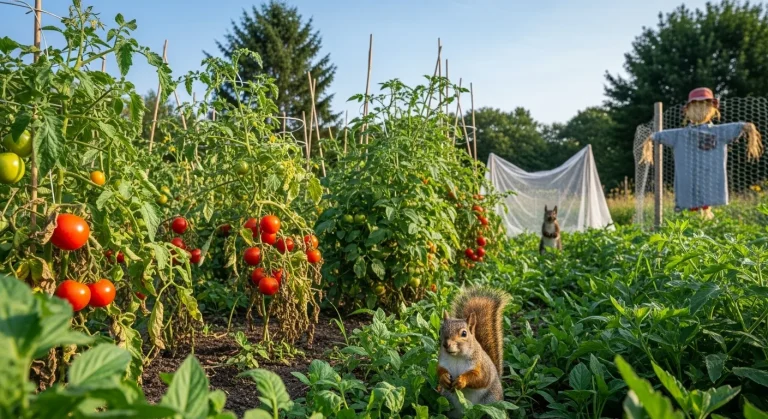Successful tomato growing depends as much on the right tools as on good seed and sound agronomy. The correct tomato growing tools save time, reduce crop losses, and produce healthier plants and larger yields.
This guide lists 10 essential tools every grower — from hobby gardener to small-scale farmer — should have. Each item includes practical buying and use tips, plus links to further reading for growers who want deeper guidance.
1. Quality pruning shears (secateurs)
Use: Removing suckers, dead foliage, and diseased stems.
Why it matters: Clean cuts speed healing and improve airflow.
Tip: Choose bypass-type secateurs with a comfortable grip and a sap groove. Sterilize blades between plants to reduce disease spread.
2. Hand trowel and dibber (planting tools)
Use: Transplanting seedlings, planting seeds, and working small beds or containers.
Why it matters: Accurate planting depth and gentle handling reduce transplant shock.
Tip: Stainless or hardened-steel trowels last longer. For seed-starting, use a dibber to make uniform holes. For step-by-step seedwork, read DIY Planting Tomato Seeds From Tomatoes.
3. Sturdy stakes, cages, and trellis systems
Use: Support for indeterminate and heavy-fruited determinate varieties.
Why it matters: Keeps fruit off the ground, lowers disease risk, and simplifies harvest.
Tip: Bamboo stakes are cheap and effective; metal T-posts and woven-wire cages are durable for larger plots.
4. Drip irrigation kit (emitters, tubing, filter, pressure regulator)
Use: Delivers consistent water to the root zone.
Why it matters: Conserves water and reduces foliar disease by keeping leaves dry.
Tip: Install pressure-compensating emitters and a filter to avoid clogging. Automated timers make watering precise and repeatable. For do-it-yourself instructions, see Drip Irrigation For Tomato Plants: Easy DIY Tips.
5. Soil moisture meter (or tensiometer) and watering can
Use: Measure soil moisture and water accurately.
Why it matters: Prevents overwatering and underwatering — both harmful to tomatoes.
Tip: In containers, check moisture daily; in the field, check multiple depths. Combine meter readings with visual checks.
6. Soil testing kit (pH and basic N-P-K)
Use: determines soil fertility and pH.
Why it matters: Tomatoes prefer slightly acidic soil (about pH 6.0–6.8). Correct nutrient balance improves fruit set and quality.
Tip: Test before planting and after major amendments. Use a lab test for detailed analysis if yields are low.
7. Mulch and a hand hoe / cultivator
Use: Mulch conserves moisture and suppresses weeds; a hoe controls weeds and loosens soil.
Why it matters: Weed pressure competes for nutrients and water. Mulch also moderates soil temperature.
Tip: Organic mulches (straw, coir, compost) work well. Use a light hoe to avoid damaging roots.
8. Garden sprayer (pump or battery sprayer)
Use: Apply foliar feeds, organic fungicides, insecticidal soaps, and preventive sprays.
Why it matters: Early, even coverage controls pests and reduces disease spread.
Tip: Clean sprayers thoroughly between uses to avoid chemical cross-contamination.
9. Protective netting, cages, and deterrents
Use: Protect plants from birds, rodents, and squirrels.
Why it matters: Fruit loss and plant damage from pests can be significant.
Tip: Use fine mesh netting over frames for birds. For ground-level protection, hardware cloth around stems helps deter burrowing animals.
10. Grow lights, cold frames or row covers (season-extension tools)
Use: Extend season, raise seedlings, or grow indoors during winter.
Why it matters: Controlled environments improve early starts and protect fruiting plants from cold.
Tip: For indoor winter growing, choose full-spectrum LED grow lights and control humidity. For step-by-step indoor methods, see How to Grow Tomatoes Indoors During Winter.
Practical buying and maintenance tips
- Scale and budget: Hobby gardeners can use basic hand tools and a small drip kit. Commercial growers should invest in durable, larger-capacity equipment.
- Material matters: Stainless steel and powder-coated metals last longer in humid climates.
- Tool care: Clean, oil, and sharpen tools regularly. Disinfect pruning tools with diluted bleach or alcohol when disease is suspected.
- Record keeping: Label varieties and note planting dates and fertilizer applications. Knowing your variety helps you pick the right support and care.
- Symptom monitoring: Yellow flowers, blossom drop, or other unusual signs can point to care or environmental issues. If you see problems, review Should Farmers Worry About Yellow Flowers on Tomato Plants for guidance.
Where each tool fits by production type
- Container growers: Must prioritize the right pot size (see The Right Pot Size to Grow Tomatoes Without Stunted Roots), moisture meter, and frequent, measured watering.
- Field growers: Invest in durable trellising, a reliable drip system, and sprayers for timely pest/disease control.
- Season extenders / protected cultivation: Focus on grow lights, row covers, and climate control tools.
Conclusion
Good tomato growing tools are an investment that pays off in plant health, yield, and time saved.
Start with quality pruning shears, a reliable planting trowel, proper support systems, and a simple drip irrigation setup.
Add measurement tools (soil test and moisture meter) and protective gear as your crop and confidence grow.
Regular maintenance of tools and attention to soil and water will reduce disease and pest problems and improve fruit quality.
For specific, hands-on guides, follow the internal links above to read about drip systems, container watering, seed planting, pest protection, and variety selection.
Use those resources together with the tools listed here to build a practical, high-yield tomato system.




Leave a Comment